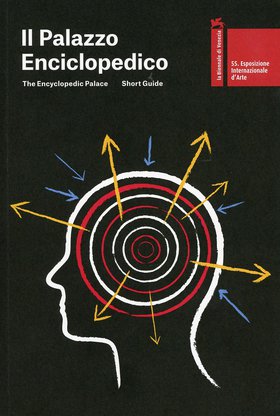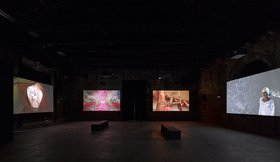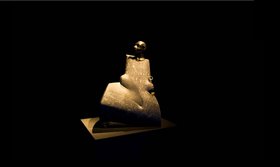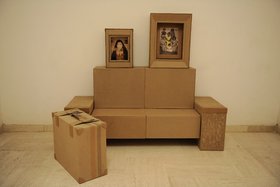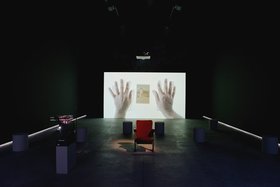Reviews
On the set of the 55th Venice Biennale
The Encyclopedic Palace
Is it pure coincidence that the 55th Venice Biennale, the world's most nationalistic 'fair' for visual culture, opened only a couple of weeks before the 2013 G8 summit took place in Northern Ireland? The play of global power relations for most cultural tourists visiting the Venice Biennale may at first seem secondary but the endless thoroughfare around which national pavilions are deserving enough of one's time amidst the 88 national participations, 47 collateral events, and the main exhibition curated by Massimiliano Gioni, most certainly illustrated a synonymous relationship between art, its markets and global power relations.
The most forthright were between the different artists posited in Gioni's International Exhibition. Here, 'outsider' artists, such as American cartoonist Robert Crumb, who occupied a major part of the Arsenale on first entry, were juxtaposed against historic figures such as Carl Andre, Phyllida Barlow, Miroslaw Balka and Tacita Dean. Elsewhere, there was a room dedicated to Carl Jung's illustrated manuscript for The Red Book (1914-1930), plastic dolls from a Chicago man called Morton Bartlett, images made by esoteric philosopher Rudolf Steiner, and work by French miner Augustin Lesage. Seeing these pieces rub up against Ryan Trecartin's epic new installation of hyperrealist alternative worlds was at times amusing, confusing, and on occasion, inspiring. It was as if a cabinet of curiosities had been unfolded, deconstructed, and disentangled into an epic library, with all of its intertextual references and nuances flowing freely. The International Exhibition curated by Gioni is a space filled with endless non-sequiturs, which will lavishly unfold beyond the life of the show itself.
'It restored my faith,' said Witte de With Director Defne Ayas of the Biennale's focal exhibit. At the time, Ayas and I were marching through the streets of Venice in protest against the violence that had just erupted in Gezi Park in Istanbul, Turkey. The themes of resilience and resistance were propelled by the (mostly) Turkish protestors marching at Venice, and were also mirrored in a multi-screen installation by the artist Ali Kazma entitled, Resistance (2013) at the Turkish Pavilion. Here, the body was seen as a permeable site, an interface, where (quite a few) bodybuilders could be seen, as they endured the physical act of shaping their bodies.
The culture of global protest however, which has become largely appropriated by a variety of different cultural producers working at both a micro and macro levels was largely absent from this year's Venice Biennale. The 54th edition's Egyptian pavilion, which showed a polemical work by the late Egyptian media artist Ahmed Basiony was this year replaced by laughable bronze, steel and granite sculptures by an artist called Khaled Zaki (who curated his own work), as well as Mohamed Banawy.
The collateral event, Otherwise Occupied, which functioned as Palestine's (un) official representation, was a slightly odd juxtaposition between two older male Palestinian artists, who both work as senior academics in western-funded universities. Aisa Deebi teaches at the American University in Cairo (AUC), and Makhoul is a professor at the Winchester School of Art at The University of Southampton, where he is the dean. (Side note: Deebi also recently attained his PhD from Southampton). Deebi's dean at the AUC, Bruce W Ferguson, curated the exhibition. The highlight of the two pieces was Makhoul's public installation, which consisted of an area where visitors could produce houses made out of cardboard boxes, which then 'occupy' a communal garden, forming a 'shantytown'. Still, despite, its participatory appeal, one couldn't help but wonder why these two figures were chosen to represent Palestine at this nationalistic fair, as opposed to one of the numerous emerging and established artistic practitioners associated with Palestine, who are much more active as artists, working full time on their practice. Jumana Manna, Ruanne Abou-Rahme and Basel Abbas, Shuruq Harb, Sharif Waked, and Khalil Rabah, are but a few examples that come to mind.
This year marked the first time Bahrain hosted its own national pavilion and unsurprisingly, its curators filled it with the work of Waheeda Malullah, which predictably consisted of photos of veiled women. Mariam Haji and Camille Zakharia also exhibited. The United Arab Emirates celebrated its pavilion's new 'permanent' status with a work by Mohammad Kazem, which was dubbed by many as an 'experience'. Sadly, the constant churning of waves in this panoramic installation failed to elicit much emotion for this viewer.
Welcome To Iraq, an exhibition curated by Ikon Gallery Director Jonathan Watkins was another disappointment, with the exhibition itself tending to accentuate the ornamental nature of the Venetian home that housed it, as opposed to the curatorial contents themselves. It seemed that the exhibition's curator was somehow unable to 'locate' these works within the context of Venice. One could potentially argue that this was because Watkins was only invited as curator a matter of months before the exhibition opened, as it was former Liverpool Biennial Curator Lorenzo Fusi who was initially invited to curate the Iraqi pavilion at Venice.
This year, Kuwait also hosted its own pavilion curated by Ala Younis, which I sadly could not make. Lebanon - with a new work by Akram Zaatari called Letter to a Refusing Pilot (2013) – boasted one of the best national participations that I was able to see. Zaatari's installation, part elegy, part reverie, is filled with obsession, lust and longing for its subjects and was one of the most consistently seductive works on display. It was only hindered by its sleekness, which at times made it lose sight of its emotional centre.
Yarat, a young arts institution, which credits itself with being the main producer of contemporary art in Azerbaijan, presented Love Me, Love Me Not, an exhibition of work from 'Azerbaijan and its neighbours'. Although, richer in content than Azerbaijan's official Venice participation, which was entitled, Ornamentation, Love Me, Love Me Not was smattered with work that traversed the decorative clichés of Central Asian art encapsulated in the mythologised western oriental imagination. This material was juxtaposed against works by more familiar international artists such as Slavs and Tatars and Kutluğ Aataman, and rounded off with a crude work by Farhad Moshiri, who used the oft-appropriated technique of printing magazine covers onto a series of small carpets.
The 'Middle Eastern' concentration at this year's Venice did leave much longing in one's imagination. To quote Massimiliano Gioni's catalogue text, 'And what is the point of creating an image of the world when the world has become increasingly like an image?' Indeed one can argue: 'and what is the point of curating an exhibition when the world has become an exhibition?' My only response would be that it is only through our own subjective experiences - through the stories (and exhibitions) that we tell to each other that we are able to communicate, not only with the present but also with history. To reference the artist and writer Judith Barry for indeed it is these narratives, which reveal the true facts (and complexities) of our lives.

